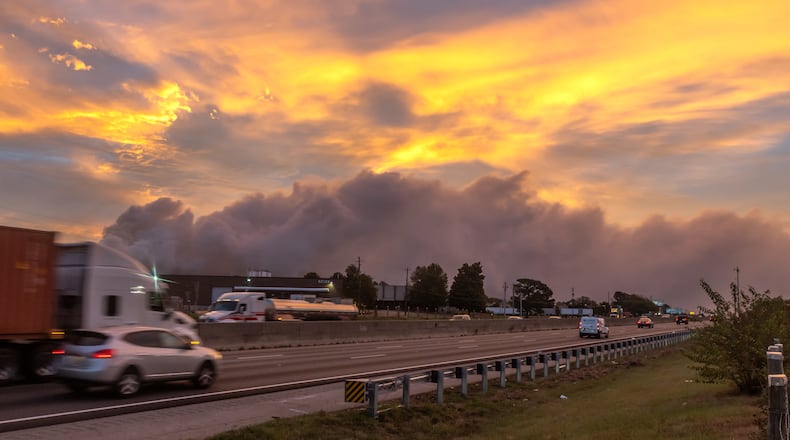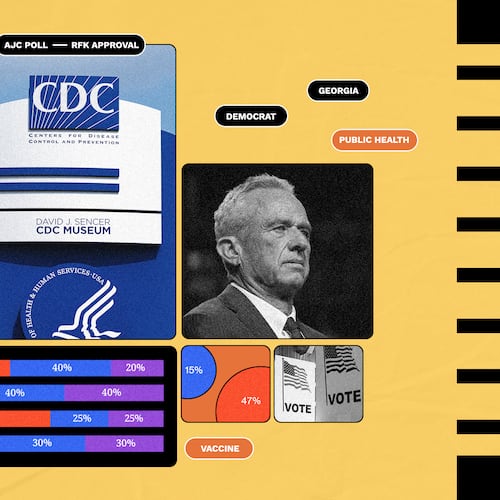According to the company’s website, BioLab makes swimming pool and spa treatment products, and chemicals involved in those products have been detected in the plume of smoke still blowing from the Conyers plant on Tuesday.
So far, public agencies say their air quality testing has not detected concentrations that would pose safety concerns to the general public, but they have advised residents of Rockdale and nearby counties to shelter indoors if they see or smell the plume.
The health effects from an exposure to the chemicals will be strongly influenced by the amount of the chemicals a person inhales and their individual health status, according to Jeremy Sarnat, an associate professor at Emory University’s Rollins School of Public Health and member of a scientific committee that advises the EPA.
In the case of the BioLab incident, officials have warned that the amount of “smoke” and chlorine compounds in the air could shift hour-to-hour based on wind direction. It might be difficult to know how much exposure a person is receiving.
Here are some basics for staying safe:
What’s in the smoke coming from the plant?
Chemicals released from the Conyers fire are chlorine, chloramine and chlorine compounds, according to an email to The Atlanta Journal-Constitution from Christen Kelley, external affairs manager for Georgia Emergency Management and Homeland Security Agency.
The EPA says chloramine is a disinfectant used to treat drinking water.
Chlorine compounds could irritate skin and mucous membranes, which include the eyes, nasal passages and respiratory system.
According to the Centers for Disease Control and Prevention’s website, when chlorine gas touches moist tissues (such as eyes, throat and lungs), it creates an acid that can harm these tissues. People with preexisting conditions affecting these parts of the body could be more likely to develop symptoms from an exposure, Kelley said.
Additionally, bromine — another chemical used in spa and pool treatments as an alternative to chlorine, and which has a bleach-like odor — also was detected, though at lower levels. Bromine exposure also can be toxic, with symptoms similar to chlorine exposure.
How much is out there?
The levels of the chemicals reported to date are below the levels previously recognized to cause symptoms in most people. However, some people can develop symptoms even at these levels, Kelley said.
Should I wear a mask?
N95 masks, which are used to protect against viruses such as the coronavirus, are likely to provide only limited benefit, if any, because the chlorine compounds are so small they are not filtered out by these masks, according to Kelley.
How will I know if I’m exposed?
According to the CDC, most people will smell the chemical or feel irritation when exposed to chlorine. Exposure for a long time can affect people’s ability to sense the chemical. Some people with asthma or other lung diseases can be more sensitive to breathing chlorine than others.
Effects depend on how the person was exposed, how much they were exposed to, and for how long they were exposed.
If chlorine is in the air, people can be exposed through skin or eye contact, or by breathing in the chlorine gas, the CDC reports. Because chlorine gas is heavier than air, it will sink to lower areas and increase the risk of exposure there.
What to do if you are exposed:
People who have severe symptoms should seek emergency care. People with nonurgent symptoms can call the Georgia Poison Center to discuss what they should do, and whether they need to seek medical care, at a special number established for this purpose: 404-856-6252.
Symptoms of exposure:
If high amounts are breathed in, breathing problems can show up right away. But if low amounts are breathed in, symptoms might show up later, according to the CDC.
Symptoms of exposure to higher levels of chlorine include the following:
- Blurred vision or eyes tearing up.
- Burning feeling in the nose, throat, lungs and eyes.
- Coughing and/or coughing up white- to pink-colored fluid.
- Chest tightness.
- Breathing problems, shortness of breath, or rapid and shallow breathing.
- Nausea and/or vomiting.
Dr. Lily Hwang of Atlanta Allergy and Asthma said Tuesday, “We recommend those who are feeling chest or asthma symptoms contact their allergist for management, as these symptoms can linger for many days after the initial trigger, causing a delay in symptom control.”
Hwang added that asthma patients should contact their allergist or step up their existing treatment plan if needed: “If your asthma is well controlled going into an event like this, the better you will fare.”
To minimize your exposure:
GEMA has advised anyone who notices a chlorine odor in the air to limit their time outdoors.
Its recommendations include limiting exposure to the chemical compounds by staying indoors with closed windows and doors, and all ventilation systems turned off. HVAC systems that are known to recirculate only indoor air can be left on in recirculate mode.
Conyers Pediatrics is posting information and advice for patients on its Facebook page. The practice suggests that turning off all kitchen, bathroom and ventilation fans “will keep the gas out of the house, and if any gets in it will sink to the floor and not get stirred up.”
Keep Reading
The Latest
Featured



